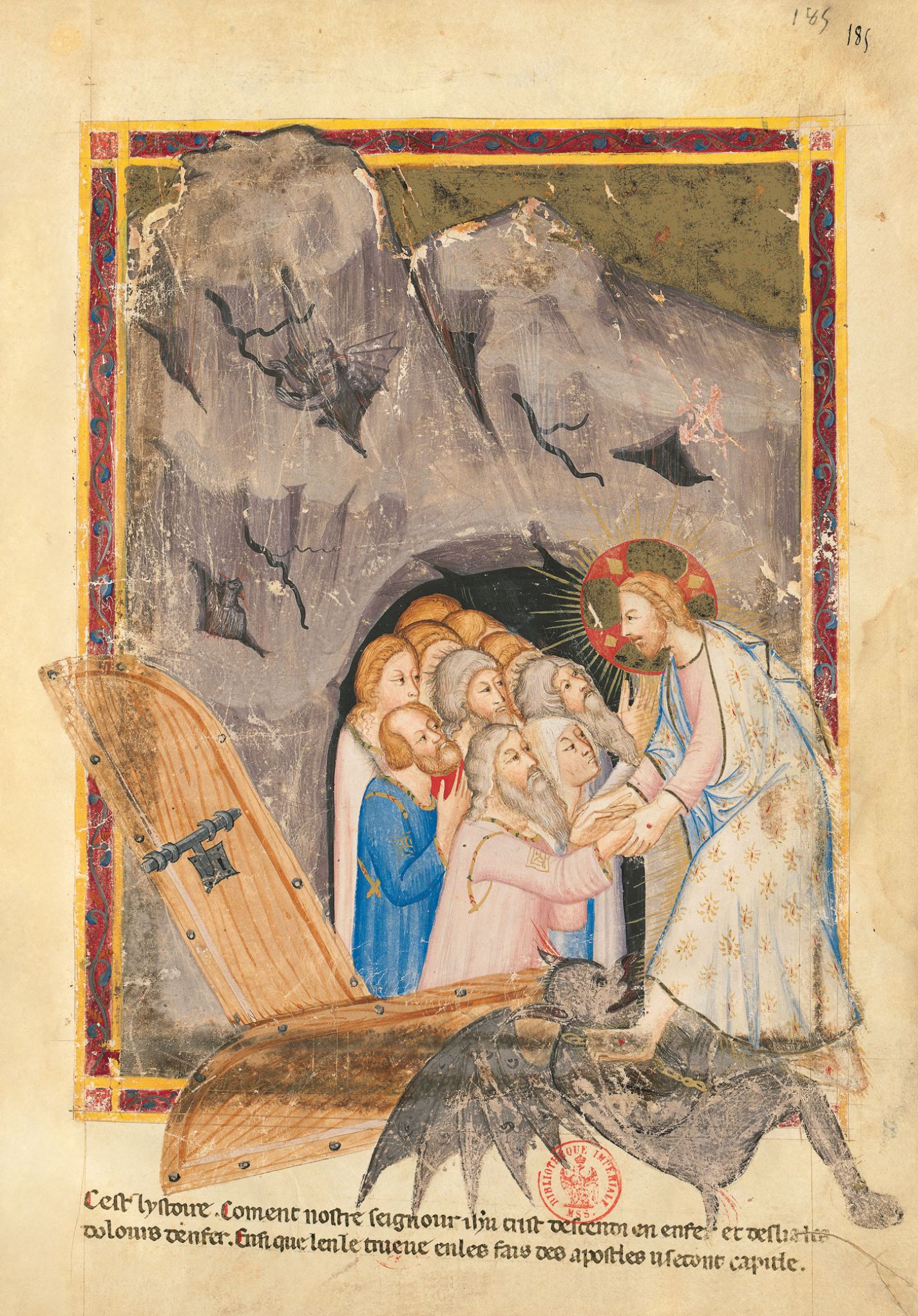“This is the story: How Our Lord Jesus Christ descended into hell and released the torments of hell. Thus is it told in the Acts of the Apostles in the second chapter.”
This image depicting Christ’s descent into hell is Painter A’s final contribution to the Old Testament cycle in the Bible of Naples. This tradition is based on an apocryphal text entitled the Gospel according to Nicodemus (chapter 24). The paraphrase, however, refers to Peter’s account in the Acts of the Apostles, where the disciple mentions King David’s 16th Psalm, “Because thou wilt not leave my soul in hell” (Acts 2: 27). Whilst he lay in his tomb, Jesus descended into the “Limbo of the Patriarchs”, a place related to both the Christian hell and the biblical Sheol where the souls of the Patriarchs are to be found. The underworld is depicted like a rocky cave forming a dome over the prisoners. Devilish bats emerge from cracks and crevices in the grotto and lie in wait for their prey. The double wooden door with an iron lock and heavy bolt has been torn off and Christ tramples a chained and defeated Satan underfoot, apparently about to topple out of the frame around the miniature. “Trampled underfoot he falls for the second time” (Luke 10: 18-19). The Messiah is still shown with the nail marks from his recent agony and the white cloak of his Resurrection strewn with golden floral motifs. The rays of light emanating from his halo with a red cross illuminate the entrance to the sinister cave. He grasps the hands of a man with a white beard and white hair identified in the text as Adam. A veiled Eve stands beside him and other Ancients crowd around behind whilst the younger ones all with blond hair wait to be released. The chosen ones have no halo because they have not participated in the coming of the Son of God but Christ extends his mercy to the chosen ones of the Old Law now as he triumphs over the Devil and his kingdom has come.
Yves Christe
University of Geneva
Marianne Besseyre
Illuminated Manuscripts Research Center, Bibliothèque nationale de France
Fragment of the Bible moralisée of Naples commentary volume

“This is the story: How Our Lord Jesus Christ descended into hell and released the torments of hell. Thus is it told in the Acts of the Apostles in the second chapter.”
This image depicting Christ’s descent into hell is Painter A’s final contribution to the Old Testament cycle in the Bible of Naples. This tradition is based on an apocryphal text entitled the Gospel according to Nicodemus (chapter 24). The paraphrase, however, refers to Peter’s account in the Acts of the Apostles, where the disciple mentions King David’s 16th Psalm, “Because thou wilt not leave my soul in hell” (Acts 2: 27). Whilst he lay in his tomb, Jesus descended into the “Limbo of the Patriarchs”, a place related to both the Christian hell and the biblical Sheol where the souls of the Patriarchs are to be found. The underworld is depicted like a rocky cave forming a dome over the prisoners. Devilish bats emerge from cracks and crevices in the grotto and lie in wait for their prey. The double wooden door with an iron lock and heavy bolt has been torn off and Christ tramples a chained and defeated Satan underfoot, apparently about to topple out of the frame around the miniature. “Trampled underfoot he falls for the second time” (Luke 10: 18-19). The Messiah is still shown with the nail marks from his recent agony and the white cloak of his Resurrection strewn with golden floral motifs. The rays of light emanating from his halo with a red cross illuminate the entrance to the sinister cave. He grasps the hands of a man with a white beard and white hair identified in the text as Adam. A veiled Eve stands beside him and other Ancients crowd around behind whilst the younger ones all with blond hair wait to be released. The chosen ones have no halo because they have not participated in the coming of the Son of God but Christ extends his mercy to the chosen ones of the Old Law now as he triumphs over the Devil and his kingdom has come.
Yves Christe
University of Geneva
Marianne Besseyre
Illuminated Manuscripts Research Center, Bibliothèque nationale de France
Fragment of the Bible moralisée of Naples commentary volume